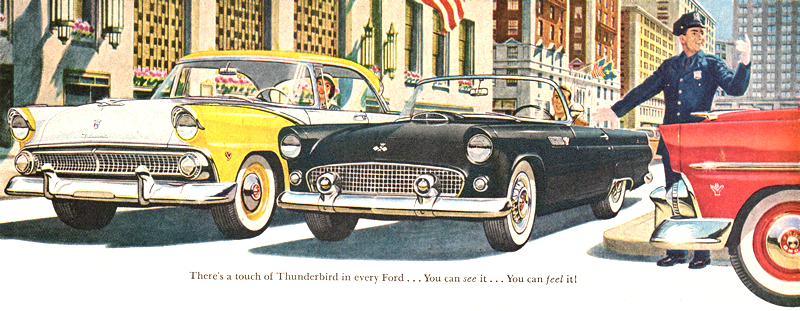Although people like to believe apocryphal legends about things, the real reason the 1955 Thunderbird ever made its appearance, in the first place, was to give Ford a two-place competitor to the Chevy Corvette.
It’s not so much that people ever really noticed that the early Corvettes tended to sound like yachts being driven before a high wind as their specialized fiberglass pieces worked and groaned against one another, it’s just that Corvette had that cachet that said “sports car” and Ford wanted to follow suit.
“American Graffiti”
It did in a big way with the 1955 Thunderbird – if you’ve every seen “American Graffiti” you see a white one cruising up and down the streets of Hicksville, wherever as our hero chases her all night – and the 1955 T-Bird was, in most ways, a better vehicle.
For starters, its stamdings were steel, not a material that Detroit didn’t know how to work with – fiberglass — so it had more body rigidity built in and with a detachable steel roof – like the ‘Vette – but with the windows mentioned, you had a real car. Actually, it was built as a “personal” sports car because, according to various sources at the time, the Corvette caught Ford flat-footed and it had to jump through hoops to get one ready for 1954 modeling and 1955 production. Well, the design team at Ford did it and even kept the wheelbase the same as the Corvette at 102.
In reality, if you look closely at the personal sports market, it was probably the T-Bird that made themarket because, event though early Corvettes only accounted for about two-percent of the market, Ford just couldn’t let go and had to have its own version.

“Personal” Sports Car
The version of the “personal” sports car that Ford produced in the 1955 T-Bird was more luxurious and practical. There was only one powerplant available, the 292-cubic-inch Mercury V-8 that cranked out 193 horsepower.
1955 T-Bird owners could opt for a three-speed Ford-O-Matic shift.
Like the Corvette, the Thunderbird featured a long hood and fenders and short rear deck. If this design sounds familiar it was the same design that helped propel the early “short platform” Mustang to its highly successful sales in 1966. The 1955 T-Bird, though, had classically straight lines that centered on the nicely designed bright front end with its widely spaced dual headlamps that were separated by a bright eggcrate-styled grille.
Nice Styling
Forerunners of the styling of the 1956/7 T-Bird, the fenders carried the lines of the headlamps back through the doors while providing a straight line back through the doors and rear deck. The short rear quarters were completed by two small rounded taillamps and the small design touches that led to the low chrome bumpers. The rear decked was short and the trunk left a lot to be desired if you wanted to haul anything.
The key to the T-Bird was its styling and its use of parts-bin pieces to bring a model to market in about 11 months or so that was a direct challenge to the Corvette
